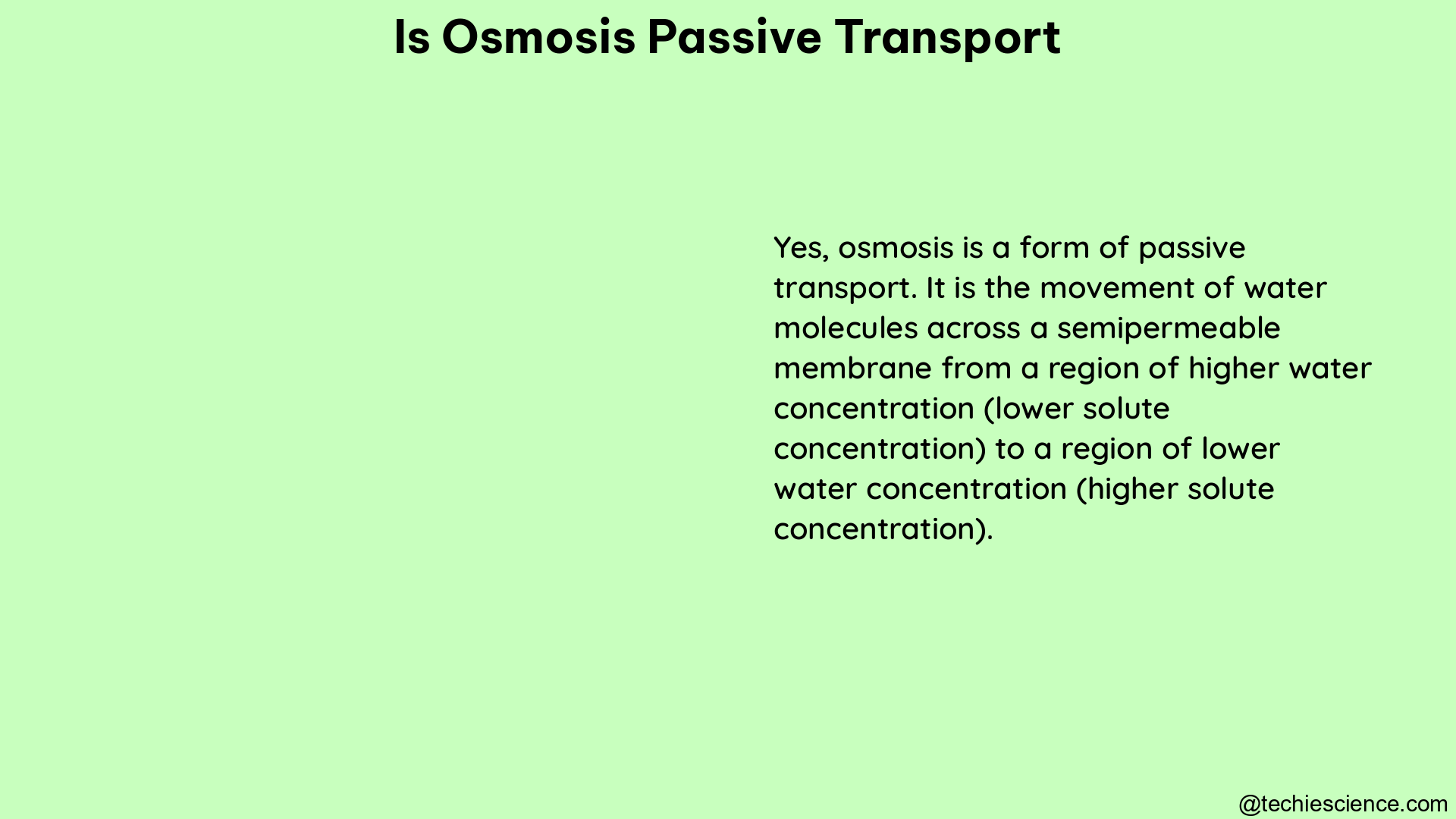Osmosis is a fundamental passive transport process that plays a crucial role in the regulation of cellular and organismal homeostasis. This comprehensive guide delves into the intricate details of osmosis, its underlying mechanisms, and the factors that influence its rate, providing a deep understanding of this essential biological phenomenon.
Understanding Osmosis: The Basics
Osmosis is the spontaneous movement of water molecules from a region of higher water concentration (lower solute concentration) to a region of lower water concentration (higher solute concentration) across a semi-permeable membrane. This movement is driven by the difference in the chemical potential of water, also known as the water potential, between the two regions.
The water potential is inversely proportional to the solute concentration, meaning that the higher the solute concentration, the lower the water potential. This concentration gradient of water is the driving force behind the passive transport of water molecules through the semi-permeable membrane.
Factors Affecting the Rate of Osmosis

The rate of osmosis is influenced by several key factors, including:
-
Concentration Gradient: The greater the difference in solute concentration across the semi-permeable membrane, the higher the rate of osmosis. This is because the larger the concentration gradient, the greater the driving force for water molecules to move from the region of higher water concentration to the region of lower water concentration.
-
Temperature: Increasing the temperature generally increases the rate of osmosis. This is because higher temperatures increase the kinetic energy of water molecules, allowing them to move more rapidly across the membrane.
-
Membrane Permeability: The permeability of the semi-permeable membrane to water molecules is a crucial factor in determining the rate of osmosis. Membranes with higher water permeability will facilitate a faster rate of osmosis compared to those with lower permeability.
-
Pressure: Applying external pressure to the system can influence the rate of osmosis. Increased pressure on the side with the higher solute concentration can slow down or even reverse the direction of osmosis, as the pressure can overcome the osmotic driving force.
Osmotic Pressure and Tonicity
Osmotic pressure is the pressure that must be applied to a solution to prevent the flow of water molecules across the semi-permeable membrane. It is directly proportional to the solute concentration and can be calculated using the formula:
Osmotic pressure (π) = i × c × R × T
Where:
– i is the van ‘t Hoff factor, which represents the number of particles the solute dissociates into
– c is the molar concentration of the solute
– R is the universal gas constant
– T is the absolute temperature
The tonicity of a solution, which describes the relative concentration of solutes compared to a reference solution, is an important concept in understanding the effects of osmosis on cells. There are three main types of tonicity:
-
Hypotonic: A solution with a lower solute concentration than the reference solution. In a hypotonic environment, water will flow into the cell, causing it to swell or even burst (lysis).
-
Hypertonic: A solution with a higher solute concentration than the reference solution. In a hypertonic environment, water will flow out of the cell, causing it to shrink or crenate.
-
Isotonic: A solution with the same solute concentration as the reference solution. In an isotonic environment, there is no net movement of water into or out of the cell.
Osmosis and Biological Processes
Osmosis plays a crucial role in various biological processes, including:
-
Cell Volume Regulation: Cells must maintain a delicate balance of water and solute concentrations to prevent damage from osmotic stress. Specialized mechanisms, such as ion pumps and channels, help cells regulate their volume and maintain homeostasis.
-
Nutrient and Waste Transport: Osmosis facilitates the movement of water-soluble nutrients and waste products across cell membranes, enabling efficient exchange and distribution within the body.
-
Plant Water Uptake: In plants, the process of osmosis is responsible for the uptake of water from the soil, which is essential for maintaining turgor pressure, supporting plant structure, and facilitating the transport of nutrients and other essential molecules.
-
Osmoregulation in Aquatic Organisms: Aquatic organisms, such as fish and marine invertebrates, must maintain the appropriate balance of solutes and water within their bodies to prevent dehydration or over-hydration. Osmosis plays a crucial role in this osmoregulatory process.
-
Dialysis and Desalination: Osmosis-based technologies, such as reverse osmosis and dialysis, are used in various applications, including water purification, desalination, and the treatment of kidney-related disorders.
Conclusion
Osmosis is a fundamental passive transport process that is essential for the proper functioning of cells and organisms. By understanding the underlying mechanisms, factors influencing the rate of osmosis, and the role of osmosis in various biological processes, we can gain a deeper appreciation for the intricate workings of living systems and the importance of maintaining homeostasis.
References:
- Passive Transport – an overview | ScienceDirect Topics
- Cellular Transport Flashcards | Quizlet
- Passive Transport: Osmosis – Principles of Biology
- 5.8: Passive Transport – Osmosis – Biology LibreTexts
- Topic 1.4 Membrane Transport

Hello, I am Piyali Das, pursuing my Post Graduation in Zoology from Calcutta University. I am very passionate on Academic Article writing. My aim is to explain complex things in simple way through my writings for the readers.